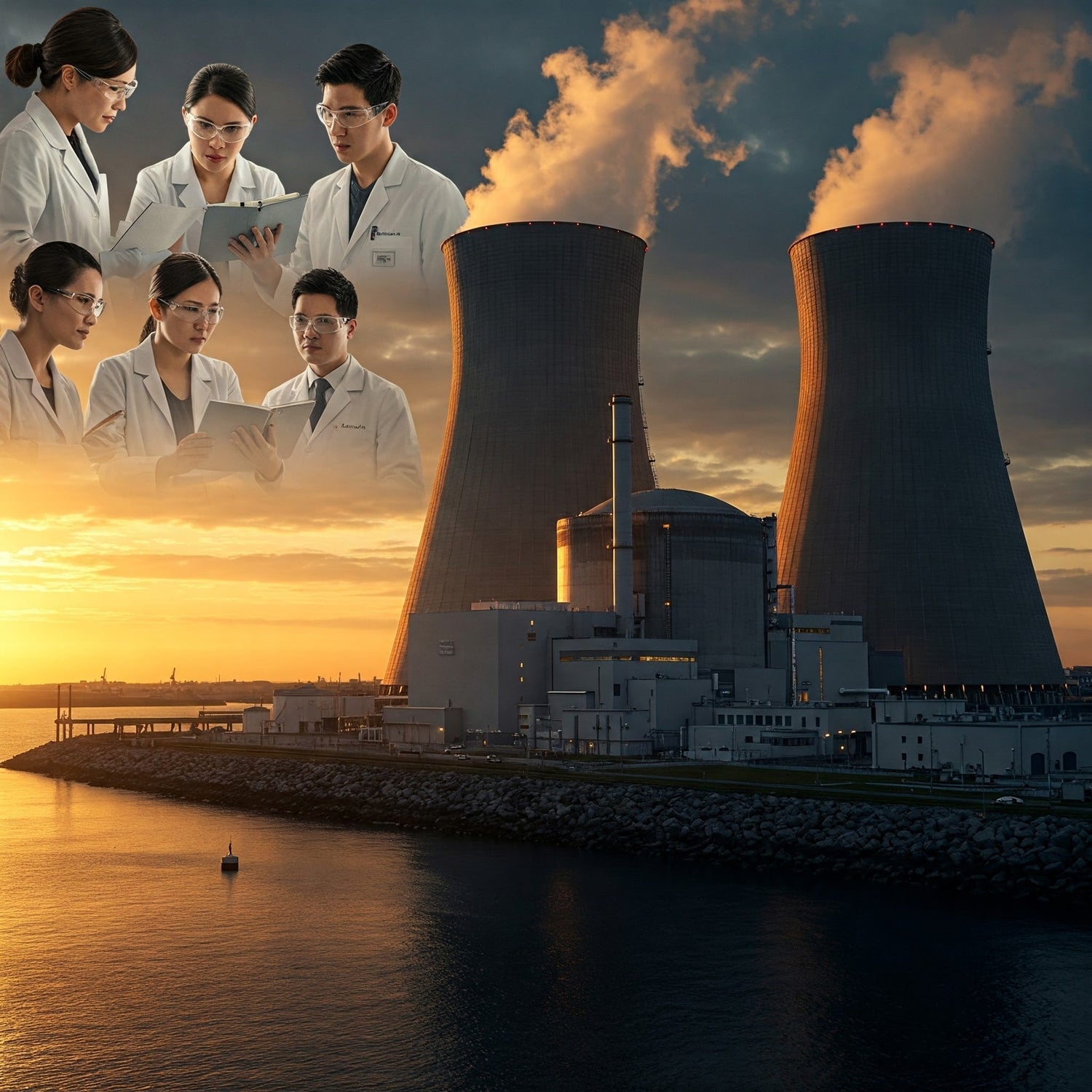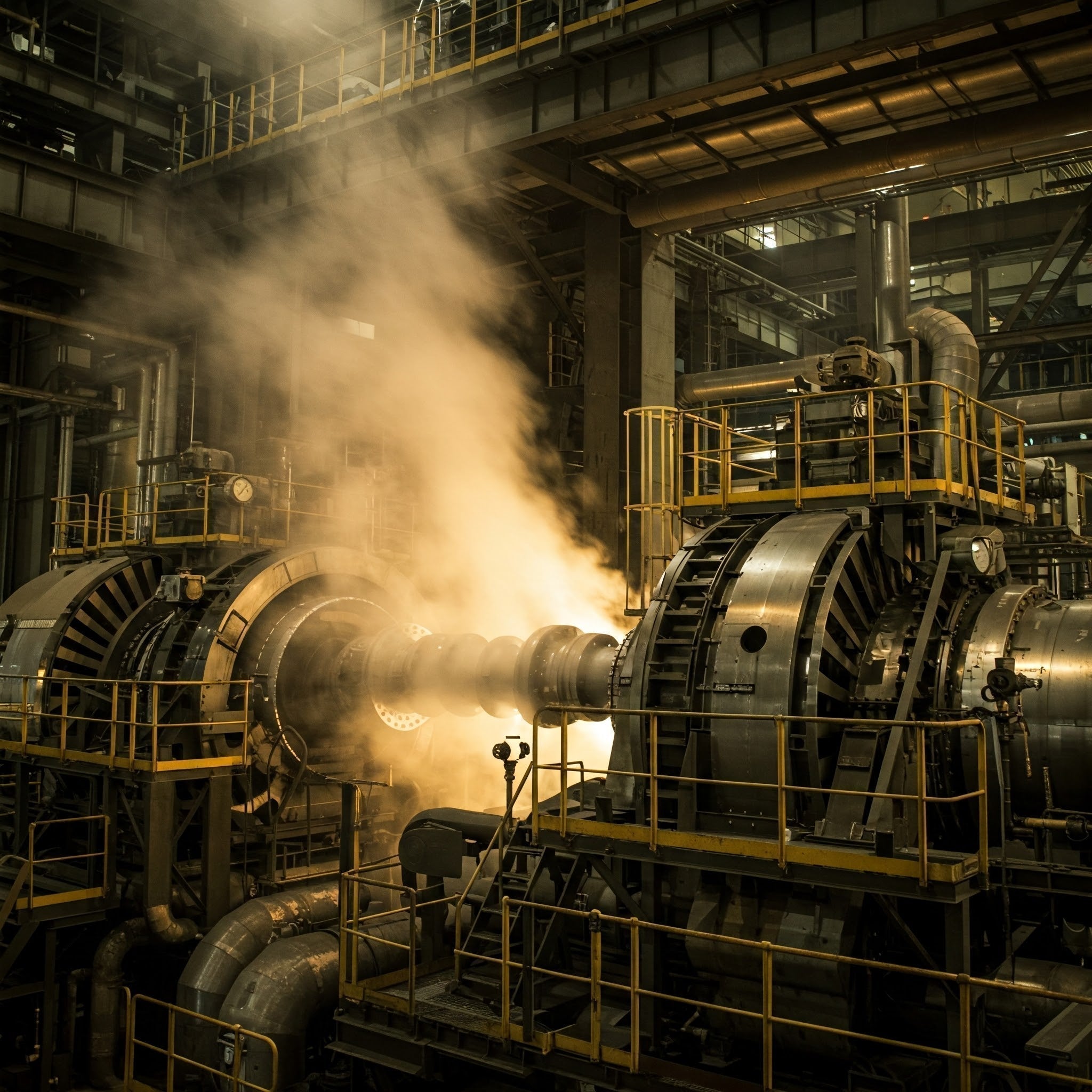When you hear ‘nuclear power,’ safety is likely one of your top concerns. Is nuclear power safe? The answer is a strong yes, as nuclear power is safe thanks to rigorous safety protocols, advancements in reactor technology, and a solid safety record. This article explores why nuclear power is considered safe, drawing on industry practices and statistical comparisons.
Key Takeaways
-
Nuclear power plants implement rigorous safety protocols and a ‘defense-in-depth’ strategy to prevent accidents, reinforced by oversight from the Nuclear Regulatory Commission
-
Advances in nuclear technology, including Small Modular Reactors and passive safety systems, enhance safety and efficiency, making nuclear energy a cleaner alternative to fossil fuels.
-
International collaboration, guided by the International Atomic Energy Agency, establishes global safety standards and promotes best practices to address challenges in nuclear safety.
What is Nuclear Energy?
Definition and Basics of Nuclear Energy Generation
Nuclear energy is a powerful form of energy that originates from the core of an atom. Atoms, the building blocks of all matter, contain a nucleus at their center, composed of protons and neutrons held together by the strong nuclear force. When a neutron collides with the nucleus of certain atoms, such as uranium, it triggers a process called nuclear fission. This process releases a tremendous amount of energy in the form of heat and radiation.
Nuclear power plants harness this energy to generate electricity. During nuclear fission, the heat produced is used to convert water into steam, which then drives turbines connected to generators. This method of electricity generation is highly efficient and produces a significant amount of energy from a relatively small amount of fuel.
One of the key advantages of nuclear energy is its low-carbon footprint. Unlike fossil fuels, nuclear power does not emit carbon dioxide during operation, making it a cleaner alternative for electricity generation. By displacing fossil fuels from the energy mix, nuclear power helps reduce greenhouse gas emissions and combat climate change.
Understanding Nuclear Power Safety

Safety measures at nuclear power plants are rigorously crafted to reduce the likelihood of accidents and lessen the impact of any unforeseen events. Significant safety improvements have been made in nuclear power reactors, especially after major incidents such as Chernobyl. These procedures have undergone substantial improvements, culminating in more stringent safety criteria and regulatory practices throughout the nuclear power sector.
Defense-in-Depth Strategy
Nuclear power plants employ a ‘defense-in-depth’ approach, which incorporates numerous levels of safety mechanisms and physical barricades within the facility. These systems are equipped with multiple redundancies to provide alternative solutions in case of malfunctions, ensuring that nuclear plants uphold these safeguards for maintaining operational soundness.
The significance of this method was underscored by the Fukushima event, highlighting the necessity for mitigating not only anticipated design-based accidents, but also serious mishaps at nuclear power stations.
Role of the Nuclear Regulatory Commission
The NRC diligently supervises nuclear plants to ensure they meet stringent safety criteria, conducting comprehensive evaluations of security, safety, and environmental factors before granting operational licenses. Nuclear power plants maintain high safety standards through comprehensive safety procedures and stringent federal regulations. This process upholds the elevated safety benchmarks requisite for managing reactors.
In its ongoing role, the NRC frequently revises and enhances safety measures. This assists in preserving exceptional levels of operational safety at nuclear facilities, positioning them as some of the most secure industrial sites across the globe.
Advances in Nuclear Reactor Technology

Nuclear technology has advanced significantly, enhancing both safety and efficiency. Innovations like AI and robotics improve reactor performance and longevity, while new designs prioritize safety and cost-effectiveness.
Enhanced Safety Features of Advanced Reactors
Advanced reactors are designed with passive safety systems that utilize the laws of physics to ensure cooling is maintained without the need for external power sources. This ensures that the reactor remains safe and cool without needing any human input, thereby lowering the possibility of accidents.
Modern reactor models employ modular construction methods which bolster safety measures while simultaneously decreasing expenses. Advancements in fuel design contribute to enhanced security by prolonging periods between refueling and reducing waste generation.
Small Modular Reactors (SMRs)
Small Modular Reactors (SMRs) represent a noteworthy advancement in nuclear technology, offering an improved safety profile and heightened efficiency when compared to conventional reactors. Their design allows for rapid construction and they are well-suited for use within smaller electrical grids, thus providing flexible energy options.
These reactors incorporate passive cooling systems designed to safeguard against nuclear reactor core meltdowns even in the absence of active power sources. This attribute significantly boosts their safety credentials, positioning SMRs as an encouraging option for the future landscape of nuclear energy.
Comparing Nuclear Safety to Other Energy Sources
Nuclear power distinguishes itself by its exceptional safety record among various energy sources. It has established itself as one of the world’s safest industrial sectors, with a mere three major accidents occurring in 18,500 reactor-years of operation.
As an alternative to fossil fuels and other methods of generating energy, including those used at nuclear power stations, nuclear power emerges as a safer option.
Death Rates per Megawatt Hour
Statistically, nuclear power results in far fewer fatalities per megawatt hour compared to fossil fuels. For example, nuclear energy has 99.9% fewer fatalities than brown coal and 99.8% fewer than coal. Fossil fuels cause approximately 24,62 deaths per terawatt-hour, significantly higher than nuclear energy.
These figures highlight the lower risks of nuclear power, making it a safer choice for electricity generation.
Environmental and Health Impacts
Nuclear energy generates minimal emissions throughout its lifecycle and does not emit carbon dioxide directly. Lignite coal, on the other hand, is associated with 32,72 fatalities per terawatt-hour, ranking it among the most dangerous forms of energy.
To fossil fuels, which are notorious for their detrimental effects on health and the environment, nuclear reactors and contemporary renewable energy sources offer a much safer and more environmentally friendly alternative.
Addressing Common Safety Concerns
Dispelling the myths and misconceptions that frequently envelop nuclear power is essential to fully grasp the true potential of nuclear energy, despite its track record for safety.
Radiation Exposure and Health Risks
Exposure to radiation from nuclear power plants is typically very low, on par with the natural background radiation we encounter daily. However, during nuclear accidents like Chernobyl, significant amounts of radioactive material are released into the environment, posing severe health risks and long-lasting contamination. When high doses of radiation are released, as in the case of the Chernobyl catastrophe, there can be significant long-term health consequences such as a heightened incidence of thyroid cancer.
Equipment like the HiStand is used to monitor levels of radiation within nuclear power facilities to guarantee that workers remain under safe limits for exposure. This device logs accumulated doses and provides warnings if these individuals approach or exceed established safety thresholds.
Handling Radioactive Waste
The generation of nuclear power results in the creation of radioactive waste that includes both low-level and high-level categories, necessitating meticulous oversight. Initially, exhausted fuel from reactors is placed into water-filled pools for cooling and then transferred to dry storage facilities where it is secured within concrete or steel enclosures.
To guarantee adherence to safety regulations aimed at safeguarding public health and preserving the environment, the Nuclear Regulatory Commission (NRC) supervises all activities pertaining to the management of nuclear waste. This encompasses its handling, transport, storage, and eventual disposal.
Lessons from Past Nuclear Accidents
Significant advancements in safety protocols and technology have been spurred by the critical lessons learned from major nuclear mishaps such as those at Chernobyl and Fukushima.
Chernobyl Accident Analysis
A considerable quantity of radioactive materials was discharged during the Chernobyl catastrophe, resulting in the creation of an exclusion zone with a radius of 19 miles surrounding the facility. Approximately 350,000 people were forced to relocate on a permanent basis because of the specific conditions surrounding this incident.
Initially encompassing roughly 1,017 square miles, the exclusion zone subsequently grew to cover about 1,600 square miles. This expansion underscores how severe the contamination from Chernobyl had become.
Fukushima Response and Improvements
The incident at Fukushima necessitated the relocation of more than 100,000 individuals, underscoring the necessity for bolstered security measures in nuclear reactors. As a result, there has been an increased emphasis within the industry on augmenting passive safety systems and making certain that portable emergency apparatuses are readily accessible for swift mobilization in case of emergencies.
Following the Fukushima event, assessments of nuclear safety within the European Union have concentrated on strengthening reactor robustness against natural calamities such as earthquakes and tsunamis.
International Collaboration on Nuclear Safety
Cooperation across nations is essential to tackle common issues associated with nuclear energy, such as ensuring its safety and security. The International Atomic Energy Agency (IAEA) is instrumental in advancing global nuclear safety standards.
Role of the International Atomic Energy Agency
The International Atomic Energy Agency (IAEA) advocates for the secure and non-violent application of nuclear technology, offering advice and assistance to its member nations. Following the Chernobyl disaster, it was instrumental in establishing a global emergency response system for handling nuclear incidents.
Cooperative efforts led by the IAEA are essential in improving nuclear safety protocols and guaranteeing that standards continue to advance in order to address emerging threats.
Global Safety Standards and Assessments
To enhance the operational safety of nuclear power, the International Atomic Energy Agency (IAEA) not only sets up safety standards but also performs inspections at global nuclear sites. These benchmarks are then customized and enforced by local regulatory authorities to suit specific regional conditions.
The cooperative efforts between international regulatory agencies have resulted in unified safety protocols and elevated safety procedures within the realm of nuclear power management.
Economic Benefits of Nuclear Power
Nuclear power plants are not only among the safest industrial facilities but also bring substantial economic benefits. These plants provide a reliable source of electricity, which is crucial for economic growth and development. The construction and operation of nuclear power plants create numerous jobs, both directly and indirectly, stimulating local economies.
During the construction phase, a nuclear power plant generates thousands of jobs, ranging from engineering and construction to project management and support services. Once operational, the plant continues to provide long-term employment opportunities for highly trained experts who ensure the safe and efficient running of the facility. This ongoing employment contributes to the economic stability of the surrounding communities.
In addition to job creation, nuclear power plants generate significant tax revenue for local governments. This revenue supports public services such as education, healthcare, and infrastructure, further benefiting the community.
Nuclear power also offers environmental advantages. Unlike fossil fuels, nuclear plants do not produce greenhouse gas emissions during operation. This makes them a cleaner energy source, helping to reduce air pollution and mitigate the health impacts associated with pollutants like particulate matter, nitrogen oxides, and sulfur dioxide.
Overall, nuclear power plants provide a reliable and sustainable source of electricity, create jobs, stimulate local economies, and offer significant environmental benefits. By maintaining the highest standards of safety and security, nuclear power continues to be a vital component of our energy landscape.
Future Prospects for Safe Nuclear Energy

Nuclear power is anticipated to have a bright future, with projections indicating an upsurge in nuclear energy production and ongoing enhancements in safety measures. The advent of novel technologies coupled with the incorporation of nuclear energy alongside renewable resources will be pivotal for our forthcoming energy landscape.
Advanced Reactor Fuels
Advanced reactor fuels are engineered to deliver advantages such as enhanced safety features, extended reaction times, and diminished production of waste. These fuels increase reliability and safety by being able to endure harsh environments.
These innovative reactor fuels play a crucial role in promoting the sustainability of nuclear energy by substantially decreasing the difficulties associated with managing waste over an extended period.
Integration with Renewable Energy
By offering a consistent and dependable supply of energy, nuclear power serves as an essential counterpart to the variable nature of renewable resources such as solar and wind. This combination is crucial in pursuing a future that relies on low-carbon energy solutions to combat the climate crisis.
Nuclear power plays a supportive role with renewables, contributing to fulfilling the needs for annual electricity consumption and simultaneously aiding in the diminution of greenhouse gas emissions.
How HiStand Enhances Personal Safety Around Nuclear Power

The Milerd HiStand plays a vital role in improving personal safety in the vicinity of nuclear plants by monitoring and recording radiation exposure levels. This enables individuals to stay informed about their radiation exposure and take appropriate measures for their protection.
Features of the Milerd HiStand
The HiStand is rugged, waterproof, and shockproof, making it suitable for extreme environments. Its built-in solar panel allows for autonomous operation over extended periods without needing a recharge.
The package includes the HiStand, a Snap Hook, USB Type-C, and a Manual, providing everything needed for effective radiation monitoring.
Practical Applications of HiStand
The HiStand is an essential tool for individuals who frequently spend time outdoors or work in dangerous settings, enabling them to track their exposure to radiation. It proves especially beneficial for those involved in construction, environmental assessments, or emergency services around areas prone to radiation dangers such as nuclear sites.
By simplifying the process of monitoring radiation levels, the HiStand plays a crucial role in upholding safety protocols and minimizing health hazards associated with nuclear installations.

Summary
By rigorously adhering to strict safety standards and utilizing cutting-edge technologies, nuclear power provides a secure and effective method for electricity generation. Dispelling prevalent misconceptions and emphasizing the advantages of nuclear energy can enhance our understanding of its significance in shaping the future of our energy supply. Integrating nuclear power with renewable energy sources is crucial for realizing a sustainable, low-carbon future.
The chapter on the HiStand highlights its vital role in enhancing personal safety around nuclear power plants. By monitoring and recording radiation exposure levels, the HiStand ensures that individuals working or residing near nuclear facilities can maintain their health and safety. Its robust features, including a solar panel for autonomous operation, make it an indispensable tool for those in high-risk environments, further contributing to the secure integration of nuclear power into our energy landscape.



Leave a comment
This site is protected by hCaptcha and the hCaptcha Privacy Policy and Terms of Service apply.